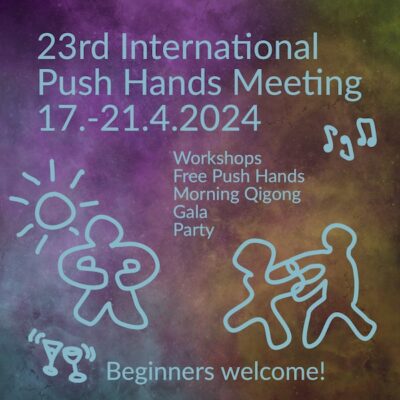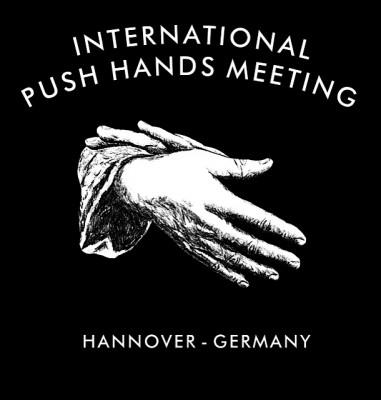Teachers and Themes of the 23rd Push Hands Meeting
| Room 1 | Room 2 | Room 3 | |
| Wednesday, 17.04.2024 | Birgit Golze | Gudula Motsch | Giles Rosbander Martin Neumann |
| Thursday, 18.04.2024 | Birgit Golze | Gudula Motsch | Giles Rosbander Martin Neumann |
| Friday, 19.04.2024 | Birgit Golze | Samuel Tinguely | Ronja Jantje Hinze |
| Saturday, 20.04.2024 | Nils Klug | Samuel Tinguely | Ronja Jantje Hinze |
| Sunday, 21.04.2024 | Nils Klug | Samuel Tinguely | Ronja Jantje Hinze |
Birgit Golze

Birgit Golze has been practicing Taijiquan for over 20 years. For 13 years, she has been teaching Taijiquan and partner exercises in her native city Dassel. Birgit discovered her passion for Push Hands during her teacher training with Master Nils Klug. Since this time, her own teaching of the form is closely linked to partner work.
Birgit’s passion for Push Hands has led her to meet national and international teachers both in Germany and internationally as well as on meetings all over Europe. Birgit also gathered valuable experience in competitions, always ranking among the first three places.
And last not least, Birgit has been a long standing member of the organizing team of the International Push Hands Meeting Hannover. It is save to say that over the years she has ”seen it all” – and she is happy to share her experience with you.
Nils Klug
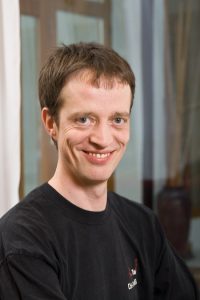
Nils Klug has been teaching Tai Chi Chuan in Hanover, Germany since 1991.
In 1993, he opened his first school. As the rooms soon proved to be too small, Nils decided to remain loyal to his Linden neighbourhood. He thus built his new school into one of the halls of the disused former factory building as part of an ecological project aimed at preserving the now listed building.
Since 1996, the Tai Chi Studio is now located at the Ecological Business Park Linden in close connection to the socio-cultural centre of FAUST e.V.
Teacher training and impulses
Nils Klug completed his teacher training with William C. C. Chen in New York. He has been teaching in his own school for over 30 years. William Chi Cheng Chen and Dr. Tao Ping Siang (Taiwan, +2006), who as Nils’ second teacher has also had a profound influence upon his Tai Chi, both have been students of Prof. Cheng Man Ching.
Nils’ further impulses are received by means of exchange with colleagues in the Chinese arts and of course his students.
Voluntary engagement for the Chinese arts
Until May 2014, Nils has been an active member of the German Network for Taijiquan and Qi Gong (“Netzwerk Taijiquan and Qi Gong e.V.”). Between 2007 and 2013, Nils served in the Taijiquan and Qigong Federation for Europe (TCFE), the European umbrella organisation for Tai Chi and Qigong, as its president. Between 2014 and 2018, Nils has been the second chairman of the DDQT (German Association of Professionals in Qigong and Taijiquan).
In his activities, Nils is committed to promoting international exchange, continual professional training and communication, crossing the boundaries of styles and schools. In this spirit, he organised the 4th Federal Qigong and Taijiquan Forum for the German Network in 1998 and the International Cheng Man Ching Forum 2004 in Hanover.
Since 2001, he and his team organize the International Push Hands Meeting in Hanover, a bilingual (English/German) indoor meeting, which takes place annually in spaces around the Tai Chi Studio in Hannover-Linden.
Over the years, Nils has been teaching at numerous Tai Chi meetings in Germany and internationally and has been hosting at great number of guest teachers from around the globe.
In addition to other online activities, Nils has also been creating an international online portal for Tai Chi and Qigong, now accessible in two languages, on which he has been continuously working during his free time.
Continuous beginners’ program
*Our bilingual workshop for Push Hands beginners follows a coordinated schedule with matching topics. It is led by Birgit Golze (Wednesday-Friday) and Nils Klug (Saturday/Sunday).
All-week workshop for beginners
First Day – Arriving and getting to know each other
Today, we will not only make contact with Pushing Hands, but also with ourselves and our partner. Together, we will try to sense, to feel, to listen and to communicate. We will search (and find?!) our centre, to be able to work with in in Pushing Hands. Simple exercises and movements will help us on our way. We will take our time: to see where to move, where to be soft in order to practice balanced and harmonious Push Hands.
Second day – Letting go: “Relaxed” in the thick of it
Our aspiration: Letting go in motion! How will I be able to let go even though somebody is trying to push me? This is the central question with which we will be dancing through our second day. – -Intentional movement and letting go are two things, which at times do not seem easy to combine. Nevertheless: to do so effortlessly will today be the goal of our exercises.
Third Day – The Push: Fundamentals
Today we are going to push! Speaking of fundamentals, many questions will emerge:What is a good push?, Where is the difference between merely shoving somebody around and a beautiful push?, Which way do I go while pushing? and: How can I succeed, trying to put all of this into one single rounded movement? – Our answer: We empty our heads and go for it! – It is really very easy:You want to push and I will show you how.
Fourth Day – Guiding our Attention
Today, we will build upon our work of the last few days and look into ourselves and our internal structure.
Using real situations that arise out of free pushing hands during the workshop as a starting point, we will tackle the following key aspects:
- The “kua”-region: Working on soft hip joints
- Neutralizing: Evading without building up pressure
- Preserving our spine – but how?
- Leaving the contact point behind – the significance of our attention
- Soft, softer, untouchable? – Strategies for Neutralizing
Simple exercises will enlighten and deepen the experiences gathered during the last days.
Fifth day – Effortlessness: The big Lever
On the last day, we go full circle: We will once again concentrate on our partner.
Using real situations that arise out of free pushing hands during the workshop as a starting point, we will tackle the following key aspects:
- Expanding: into the space of the Other
- Moving our partner intelligently
- Effortless: Aligning our hip area
- Pushing effectively: Angles and Inclinations
- Hints on how to fine tune your push
Simple exercises will enlighten and deepen the experiences gathered during the week.
Ronja Jantje Hintze
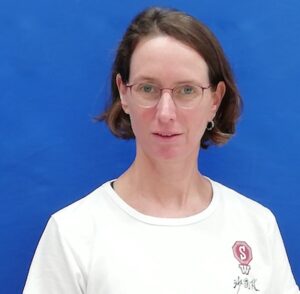
Furniture maker, Occupational Therapist, Taijiquan and Qigong instructor. work as a Body-therapist at a psychiatric and psychotherapeutic clinic.
(Tai Chi) Life
In 1999, I went to Asia as a traveling craftswoman. A knee injury was to change my originally planned life. In 2005, during my convalescence, I found Angela Menzel and the Tai Chi Schule Göttingen. I started to learn Taijiquan, Qigong followed by Baguazhang, Tongbei and Xingyiquan.
Several training trips took me to the Sha family in Kunming, who are in regular contact with the Göttingen Tai Chi Schule Göttingen through Angela.
By 2007, I was so captivated that I began my teacher training. Learning and teaching have shaped me and my professional career ever since. Angela is still my most important teacher and companion.
I completed my Qigong training with Angela Menzel and Ramona Heister. Ramona’s Qigong in combination with the therapeutic approaches of the Laoshan Center is a great enrichment and complement to Sha Wushu.
WORKSHOP
On the basis of push hands patterns (An-Pushhands, Diamond steps, etc.) we will focus on the following aspects:
- the direction of movement
- transitioning
- leading + following
- Yin/Yang relationships
- Application of the center
- Attention given to the other person
All of these components support the development and unfolding of a joint and cooperative interplay. With a little patience, you can experience a mutual and enjoyable flow of movement.
Gudula Motsch
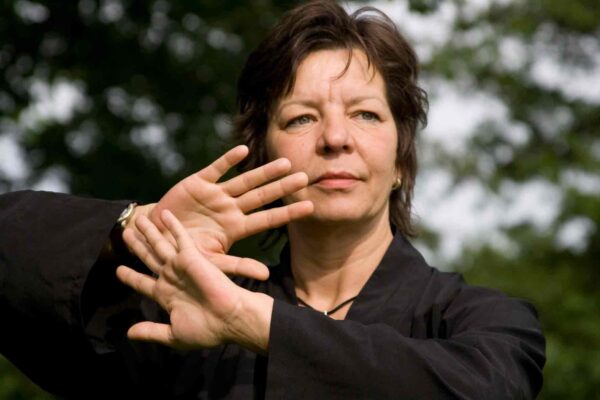
In 1993, I began to study the short and long form of Cheng Man Ching with Ulla Fels – later, Daniel Grolle and Philip Domnik also introduced me to Push Hands. In 2009, I became interested in the Wudang style and shortly after that I became a student of Sifu Tian Liyang from the Wudang mountains in China. In his school in Wudangshan (China), I studied the Michuan Taiji (64 form) and since this time I regularly study with him at his workshops in Germany. In addition to many Qigong forms, I also learned Xingyi-Bagua – a mix of Bagua and Xingyi – from Sifu Tian Liyang.
Since 2003, until the beginning of the Covid pandemic, I was a regular guest at all relevant international push hands meetings, and in the course of the years my push hands got countless impulses due to my participation in many awesome workshops.
Also in 2003, I began to teach: first in Hamburg, then in my own school in Freiburg, and now in Friedberg (Hessen). Since my authorisation by Tian Liyang in 2014, I teach the Wudang style.
I have also been on the road regularly, as a volunteer judge in international Tai Chi and Tui Shou competitions: London Competition for Traditional Tai Chi Chuan (2012 and 2013), German Taiji Open (2012) und Wu Wei Cup (2012, 2014, 2018 and 2021).
The spiritual force of Yi in Push Hands
We all have heard during our Tai Chi and Push Hands training that the Yi guides the Chi, which means that our energy follows our attention/focus. – But what does that mean exactly in Push Hands? We will explore different aspects of this spiritual force to better understand its nature and to be able to use it more precisely.
Samuel Tinguely
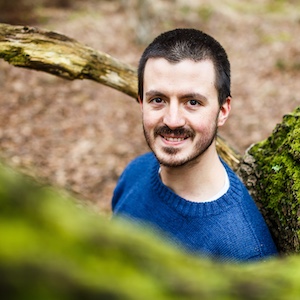
Samuel discovered push-hands during kung fu classes in 2003 in Geneva, and has been in love with this practice ever since. During these classes, he learned some basics of meditation, qigong and taijiquan. When the kung fu school he was studying at closed in 2010, he pivoted to taijiquan, learning with Dominique Flaquet, a student of Master P’ng Chye Khym. There, he studied Yang style taijiquan and practised tuishou religiously. By that time, Samuel was also an accomplished dancer and dance teacher.
In 2015, Samuel moved to London and had to find a new teacher. Very luckily, he found Master Yan Long Jiang, disciple of Grandmaster Zhan Bo from Harbin. With Master Yan Long Jiang, Samuel learned Wu style taijiquan and deepened his knowledge of tuishou, spending hours weekly practising one-on-one with the master. During his stay in London, Samuel also learned Soft Tissue Therapy (a form of remedial massage therapy) and studied qigong from Master Yan Long Jiang, books by Dr. Yang Jwing-Ming and directly from Masters Faye and Tary Yip. Studying under the latters, he is now a recognised Health Qigong Instructor. Throughout this period, Samuel also taught blues and folk dancing in several festivals throughout Europe.
Samuel moved back to his native city of La Chaux-de-Fonds (Switzerland) in 2018, where he started teaching taijiquan and health qigong, in parallel to his massage practice. He started taking part in international events as well, attending Tai Chi Tcho in La Chaux-de-Fonds in 2019 and the 20th Push-Hands meeting in Hannover in 2020. This broadened Samuel’s approach and allowed him to deepen his knowledge of the styles he knew well. He now teaches many weekly classes in both Wu style taijiquan and health qigong, as well as regular workshops about health qigong and meditation. He also organises monthly tuishou meetings in his town, where people from diverse styles meet to share their love for the discipline.
This history, combined with Samuel’s passion for anatomy and the human body, gives him a unique perspective to share ideas around tuishou, ranging from mechanics to more esoteric approaches.
Basic peng-lü drill, open to complete beginners (but not only).
In this workshop, you’ll learn a basic drill to explore the two fundamental jins (“powers”) of pushing hands : peng and lü. Once the basic shape works, we’ll use many prompts, images and other cues to refine our practice of these two jins and enrich our push-hands. I’ll also talk a little bit about the limitations of this drill and how to use it most effectively to avoid frequent pitfalls.
Anatomy and biomechanics for tuishou.
The effector of our intention is the body. For this reason, learning about our body and how it functions will help us realise our intention more fully. In this workshop, you’ll learn about basic anatomy and body mechanics, and a little bit about how to put it to good use in your push-hands. Our exercises will focus mostly around the hips and shoulder.
Breathing, meditation techniques and qigong for tuishou.
As tuishou comes mostly from internal martial arts, it comes to reason that internal techniques would help one practice push-hands with more depth. In this workshop you’ll learn breathing techniques, meditation practices and qigong principles to help you foster your internal strength. Some level of mastery of abdominal breathing is strongly recommended for this workshop.
Giles Rosbander / Martin Neumann
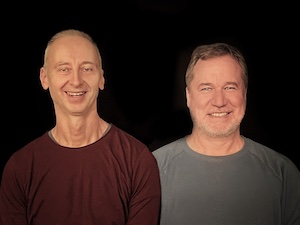
Giles Rosbander (formerly Giles Busk) had a background in dance theatre (Amsterdam) when he started studying Tai Chi Chuan (Cheng Man Ching style) with Wilhelm Mertens in Hamburg in 1996. He then trained with Nigel Sutton and several Malaysian-Chinese teachers, including Lau Kim Hong, in Malaysia (CMC style), also with Ömer Humbaraci in Hamburg (Shayuquan style) and then nine years with Fernando Chédel (Ma Tsun Kuen style). He received and continues to receive further inspiration through encounters with many other practitioners; he highlights several seminars with Dr Tao Ping Siang as a particular source of inspiration. He also gained experience in other Tai Chi styles and other martial arts and sports, e.g. MMA, Aikido, Bagua Zhang, Wing Chun and Systema.
He runs the ‘Cloud Hand Tai Chi Berlin’ school and gives seminars in Germany and internationally.
Martin Neumann started martial arts with judo and intensive karate training (Shotokan), then began practising Qi Gong and Tai Chi Chuan in the Peking and Yang styles at the age of 16. His most important teacher in Yang style was later He Lin Lin from Qingdao / PR China. It was under his guidance that he first understood the concept of lively and combative Tai Chi Chuan. Martin has been studying with Fernando Chédel since 2005. After initial difficulties – many things differed from what he thought he knew or was even able to do – he has immersed himself deeper in the Ma Tsun Kuen style over the years. Further inspiration came and comes from the Huang School, from Bret Hall (Cheng Man Ching style) and through lively exchange with other teachers, including Epi van de Pol.
He runs the DAO Centre Berlin and teaches at seminars in Germany and internationally.
Martin and Giles have been close friends for years; each has their individual, but related, teaching style. Their dialogue-based teaching creates a three-dimensional learning environment, which they convey in their ongoing seminar series “Tuishou Stereo”.
TuiShou is not fighting. So what is it then?
In tuishou, practitioners often end up struggling against each other. Or it may be the opposite: they have such a soft focus that the movements lose meaning.
Practicing tuishou/push hands shouldn’t really involve these two extremes. So what should it be about?
In our view, tuishou is an exercise method which develops the tai chi qualities for martial use. And at the same time it’s a way of training good human interaction.
If we want to practice the tai chi qualities together, it’s important to recognise our own (physical) resistance, to dissolve it again and again, and to find an accepting and connecting touch instead. This always in the sense of a practical martial art. To achieve this, we support each other in a clear and generous way.
Moving from seemingly simple partner exercises to free tuishou, Martin and Giles take you on this journey. As part of this process they also demonstrate their training interactions with each other, also in moments of potential conflict.
TaiChi is round. So is TuiShou!
We all know that tai chi chuan is ‘round’. But in real-life tuishou practice we often experience a linear back-and-forth – with a lot of rough edges and friction.
If we can manage to create three-dimensional roundness and can ‘surf’ on this, then tuishou becomes more fluid, more relaxed and at the same time more efficient in terms of practical martial art
Using the partner exercises in the workshop, we explore how this roundness can be created and kept alive. We experience how we go with the flow, ride the waves, and at the same time maintain a clear focus. This gives us the ability to adapt and to transform.

